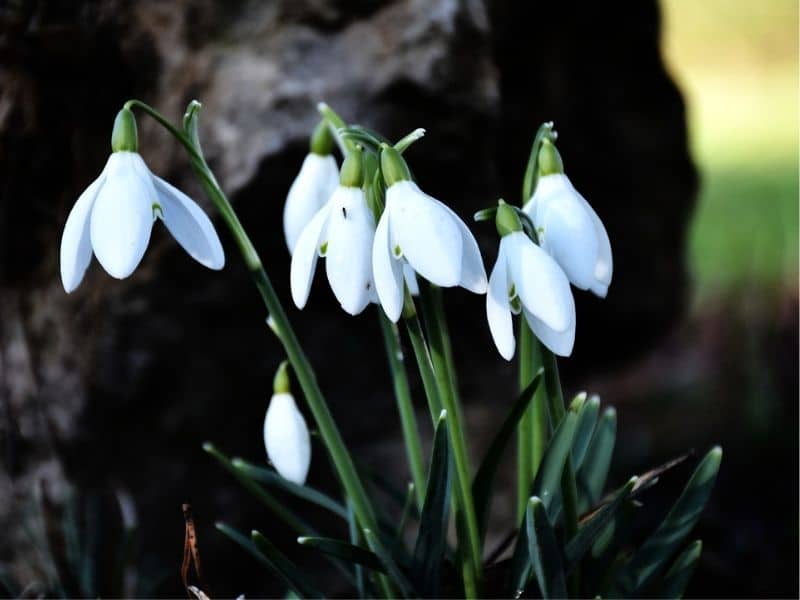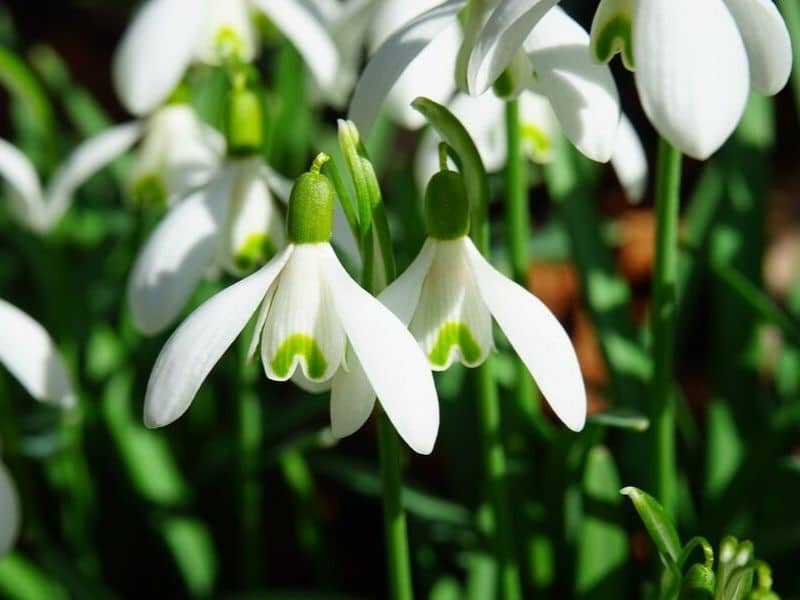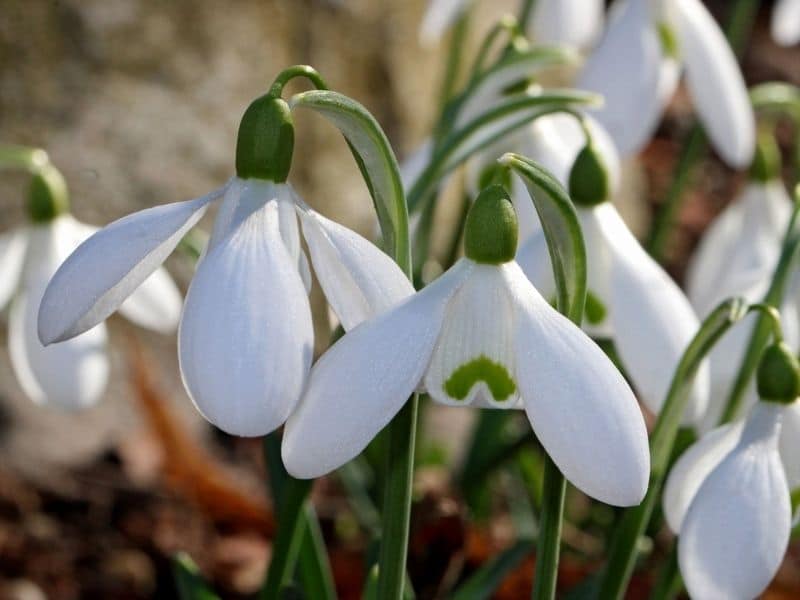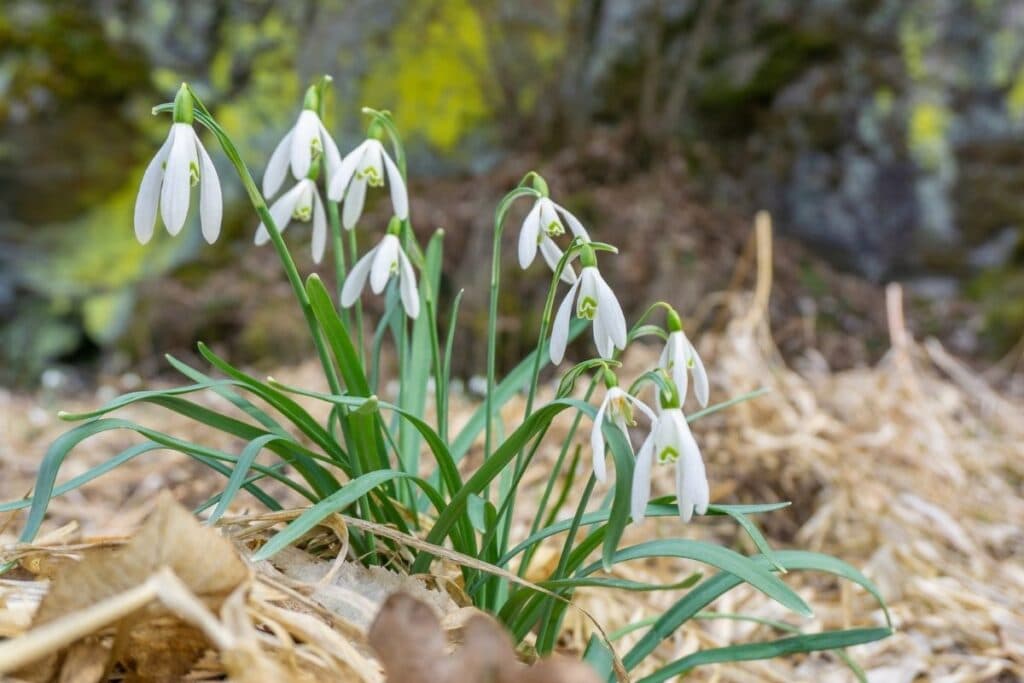The sight of snowdrops poking up through the snow indicates that spring is near. These small yet highly attractive plants grow best when planted in clusters in rock gardens, pollinator gardens, borders, or along walkways. Give them the right conditions and care, and you will be rewarded with beautiful bell-shaped and fragrant small, white flowers when they’re in full bloom.
Read on below to learn about snowdrops, including their different types, facts, as well as growing and caring tips.
What are Snowdrops?
Snowdrop (Galanthus spp.) is a genus of flowering plants from the Amaryllis family of about 20 known species (1). Plants in the genus are bulbous and herbaceous perennials. They are closely related to other famed flowering plants like daffodils and amaryllis.
Galanthus plants are generally low maintenance and require minimal care. They grow best in USDA hardiness zones 3 to 9, depending on the species and cultivated varieties. They naturalize and reproduce when left uninterrupted, and thrive best under the shade of trees and deciduous shrubs. The fragrant flowers attract pollinators and bloom in mid-winter to early spring (2).

Plant Description
Snowdrops are deciduous plants with a clumping, erect, or spreading growth habit (3). They are known for their white, bell-shaped flowers. They vary in size, but the Common Snowdrop (Galanthus nivalis), one of the most popular species of Galanthus, grows only about 3” to 6” tall. The Giant Snowdrop (Galanthus elwesii), on the other hand, reaches up to 14” to 16” in height (1).
These plants flaunt attractive linear, grass-like, gray/silver, or green foliage. Each leaf measures about 3 to 6 inches in length and 1 inch in width (3). When they bloom, they give a charming display of drooping small, white flowers. Each bell-shaped flower has six sepals, mostly with hints of green markings on the inner sepals (1), but it varies on the species.
Origin and Distribution
Most of the snowdrop plants in the genus originated from Europe and the Middle East (1). They are naturalized in parts of the United States, including North Carolina and Virginia (3).
Fun fact: Snowdrop is a January birth month flower. It’s often given to people who are born in January.

Popular Snowdrop Varieties and Types
Snowdrops are one of the most popular spring-flowering plants that can instantly brighten up any space with their delicate and fragrant blooms.
There are tons of snowdrop cultivars available, and if you’re still not too familiar with these perennials, then it’s completely understandable if you think they usually look similar to one another.
Snowdrops can either have single or double flowers, depending on the varieties. They often have markings on their inner petals, and these features help identify the cultivars.
Here are the most recognized varieties and types of Galanthus plants.
Common Snowdrop (Galanthus nivalis)

Common Snowdrop or Galanthus nivalis is perhaps the most popular species of Galanthus available for garden use. It grows up to about 6 to 12 inches in height and spreads up to 6 inches.
When in full bloom in late winter to early spring, it showcases a striking display of dainty white flowers with a distinctive green spot at the tip of each petal. Common snowdrop is a recipient of the Royal Horticultural Society’s Award of Garden Merit.
Known varieties and forms of common snowdrops:
- Double snowdrop (Galanthus nivalis F. pleniflorus ‘Flore Pleno’)
- Galanthus nivalis Sandersii Group
Giant Snowdrop (Galanthus elwesii)
Galanthus elwesii, commonly known as Giant Snowdrop or Greater Snowdrop, grows in USDA hardiness zones 4 to 7. They reach up to 12 inches tall and spread about 3 to 6 inches.
The flowers of Giant Snowdrop resemble that of the Common Snowdrop – white, bell-shaped, waxy, and flaunt green markings at the tip of each petal. However, they are bigger hence the common name Giant Í.
This Galanthus species obtained its name from Henry John Elwes, a British botanist who found it in Turkey. One of the most popular varieties of this type of snowdrop is the One-spotted Elwes’ snowdrop (Galanthus elwesii var. monostictus).
Galanthus’ Wendy’s Gold’ (Galanthus plicatus’ Wendy’s Gold’)
Galanthus ‘Wendy’s Gold’, otherwise known as Pleated Snowdrop, is a popular yellow type of snowdrops. These plants produce delicate white flowers with distinct hints of yellow at the center in late winter to early spring. When in bloom, the flowers hang beautifully from an arching pale green small stalk.
The Wendy’s Gold cultivar of snowdrops grows about 4 to 8 inches in height and spreads about 3 to 6 inches. It’s a low maintenance plant and hardy in USDA hardiness zones 3 to 8.
Woronow’s Snowdrop (Galanthus woronowii)
Galanthus woronowii, more recognized as the Woronow’s Snowdrop or the Green Snowdrop, is a type of Galanthus that’s native to Turkey and Russia. It is a compact perennial that grows up to 6 inches tall.
The shiny bright green, strap-like leaves set the Woronow’s Snowdrop apart from the other types of Galanthus as they are broader. The small flowers, on the other hand, are white with distinctive hints of green at the base of the inner petals.
This species of snowdrop is named after Russian botanist Georg Woronow.
Galanthus ‘S. Arnott’
A popular snowdrop cultivar, Galanthus ‘S. Arnott’ features elegant, fragrant, and rounded blooms that measure about 1.25 inches long. The flowers rise atop upright stems and recognized for their v-shaped green markings at the tips of the inner petals.
Like other Galanthus types, these snowdrops bloom in late winter to early spring. The leaves are narrow and gray-green. Galanthus ‘S. Arnott’ is a classic favorite of many gardeners and a frequent sight in home gardens.
Galanthus ‘Atkinsii’
Galanthus ‘Atkinsii’ is an award-winning snowdrop hybrid that features nodding white blooms. The flowers are bell-shaped and feature long and narrow outer petals.
The inner petals, on the other hand, display nice heart-shaped green marks at the tips. The plants grow up to 8 to 10 inches in height and spread up to 3 to 6 inches.
Galanthus ‘Primrose Warburg’
‘Primrose Warburg’ is a medium-sized cultivar of snowdrops that grows up to 8 inches. Like other plants in the genus, it showcases delicate nodding white blooms and striking leaves. Their difference, however, is the sizable golden-yellow ovary on top of the petals and the matching yellow to lime-yellow markings at their smaller inner petals. The outer petals are white and occasionally have pale green veining. The leaves of this cultivar are pale blue-gray, strap-like, and slightly roll outward.
Galanthus ‘White Swan’
Galanthus ‘White Swan’ is a one-of-a-kind Greatorex Doubles snowdrop. Greatorex Doubles is a series of snowdrop hybrids developed by renowned snowdrop breeder Heyrick Greatorex. ‘White Swan’ features charming white flowers with upside-down u-shaped markings at the tips of the inner petals. The plants are tall and, when planted in groups, form a nice clump.
Galanthus elwesii ‘Mr. Blobby’
An eye-catching cultivar of Giant Snowdrops is known as the ‘Mr. Blobby’ as named by snowdrop expert Joe Sharman. This attractive snowdrop cultivar features prominent large white flowers. While the majority of Galanthus has three outer petals, it occasionally features four outer petals instead of three.
How to Grow and Care for Snowdrop Flowers

Knowing the required conditions for growing snowdrops will give you an advantage in achieving healthy and thriving plants for your garden. With the right care and suitable growing environment, you can be sure that your snowdrop plants will be at their optimum state.
Planting Snowdrops
These delicate plants are typically reproduced through division or stem cuttings (3). If you’re not sure how to do that, you have one less thing to worry about since you can often purchase ready-to-plant snowdrop bulbs or potted plants from garden centers.
Galanthus prefers cooler climates. Divide clumps of snowdrop bulbs and plant snowdrops into groups to display white bell-shaped blooms in full bloom. Planting a group of bulbs about 2 to 3 inches deep, ideally in late spring when the leaves are still green, will yield more flowers and create a beautiful garden display.
Light
Snowdrops grow best when planted in dappled shade to full sun (1). They require at least six hours of direct sunlight a day. However, they can also thrive in part shade, where direct sunlight is limited to 2 to 6 hours a day (3). Sufficient sunlight will encourage snowdrop flower production of these plants.
Soil
These dainty and delicate plants tolerate a wide range of soil conditions, but they prefer a rich humus soil that is well-draining (1). Although they can withstand a variety of soil types like clay, loam, sand, and chalk, snowdrops do not like soggy and waterlogged conditions.
They are also not fuzzy about the soil pH as they will grow in acidic, neutral, or alkaline soil types. The key to successfully growing vigorous snowdrop plants is to keep the soil moist but well-draining.
Water
While established snowdrops can tolerate drought, these plants require light to moderate water to achieve optimum growth (1). In warmer climates, however, it will require more water.
Keep the soil moist throughout the growing season, but make sure to avoid overwatering since doing so may cause the Galanthus bulbs to rot. Underwatering, on the other hand, may cause your plants to wither.
Snowdrops grown in containers tend to dry out and freeze faster than in-ground plants. Thus, it’s important to use pots that provide good drainage and position them at a sheltered location.
Temperature
Snowdrops are hardy plants that can withstand low temperatures. For snowdrops to produce charming flowers, they need a cold period with temperatures below 20°C (1).
Fertilizing
As with other flowering plants, snowdrops will benefit from the use of fertilizers. Though snowdrops flower will survive without fertilization, feeding them with the right fertilizer will encourage flower production and vigorous growth. Feed your plants with potassium-rich fertilizer every 7 to 10 days when their leaves first appear.
Propagate Snowdrops
Snowdrops can be propagated through division or seed sowing. To divide snowdrops, carefully lift clumps of bulbs after flowering and gently separate them into smaller clusters, ensuring each division has roots attached.
Replant the divisions immediately at the same depth as the original bulbs in well drained soil. Alternatively, collect ripe seeds in early summer, sow them in pots or trays filled with a suitable potting mix, and keep them moist until germination occurs.
Transplant the seedlings into the spring garden once they have developed sufficient roots.
Are Snowdrops Poisonous?
Galanthus can be toxic when ingested. The bulbs, in particular, are poisonous and may cause nausea, vomiting, and diarrhea if eaten even in small quantities. The flowers and leaves are also poisonous to pets and humans (3). The sap may cause skin irritation (4).
Common Pest and Diseases of Snowdrop Flowers
Snowdrops have no serious insect pests and diseases. However, high soil pH may cause leaf scorching in some plants (3). These plants may occasionally get infested by narcissus bulb fly, slugs, and snowdrop grey mold. The seedlings may encounter damping off.
Narcissus Bulb Fly
Narcissus bulb flies are common insect pests that affect various flowering plants, including amaryllis, daffodils, lilies, and tulips. They feed on the bulb and flower buds. When infected, the bulbs may rot and cause damage to the plants. Narcissus bulb flies can be controlled by destroying infested bulbs, removing plant debris, or applying a hot water bath to plant bulbs (5).
Slugs
Slugs are pests that feed on a wide range of plants, including snowdrops. They occasionally damage Galanthus plants by feeding on the leaves and flowers. Early detection and elimination help control these pests quickly. You can remove slugs from the area by hand-picking or setting up traps and barriers (6).
Snowdrop Grey Mold
Snowdrop grey mold is a plant disease caused by a fungus called Botrytis galanthina. Mild winters promote the development of this disease. When infested, snowdrops exhibit fuzzy grey mold and collapsing leaves and flowers. The bulbs may also show small, seed-like formations on the surface. Removing the affected bulbs and plant parts is one of the easiest ways to control the grey mold of snowdrops.
What can I plant with snowdrops?
- Hellebores
- Crocus
- Dwarf Iris
- Winter Aconite
- Daffodil
- Cyclamen
- Snowflake
- Grecian Windflower
- Squill
- Glory of the Snow
- Fragrant Honeysuckle
- Peonies
- Sedums
- Paperbush
- Coral Bells
- Black Mondo Grass
FAQs
Where do snowdrops grow best?
Snowdrops (Galanthus) grow best in cool climates with moist, well-draining soil. They thrive in partial light shade or dappled sunlight, making them ideal for woodland gardens or under deciduous trees.
What does snowdrops need to survive?
Snowdrops need adequate moisture during their growing season, typically in late winter to early spring. They also require well-draining, moist soil to prevent waterlogging, which can lead to root rot. After flowering, allow the foliage to die back naturally to replenish the bulbs for the next season.
Will snowdrops grow in full sun?
While snowdrops prefer partial shade, they can tolerate some morning sun or filtered sunlight. However, in regions with hot summers, protecting them from intense afternoon sun is beneficial to prevent stress and prolong their blooming period.
Are snowdrops easy to grow?
Yes, Snowdrops are generally considered easy to grow, especially in regions with suitable climates. Once established, they naturalize readily and require minimal maintenance. They are also relatively pest and disease resistant, making them a popular choice for beginner gardeners.
Up Next: Snowdrop Flower Meaning and Symbolism
References
Reference list
- Snowdrops (2020). Available at: https://extension.psu.edu/snowdrops
- University of Washington Botanic Gardens. 2011. February 2011 Plant Profile: The Genus Galanthus. [online] Available at: <https://botanicgardens.uw.edu/about/blog/2011/02/04/february-2011-plant-profile-the-genus-galanthus/>
- Galanthus nivalis (Common Snowdrop, Snowdrop) | North Carolina Extension Gardener Plant Toolbox (2020). Available at: https://plants.ces.ncsu.edu/plants/galanthus-nivalis/
- Resources, U. (2020) Toxic Plants (by scientific name), Ucanr.edu. Available at: https://ucanr.edu/sites/poisonous_safe_plants/Toxic_Plants_by_Scientific_Name_685/
- Narcissus Bulb Fly (2020). Available at: https://mrec.ifas.ufl.edu/lso/entomol/ncstate/fly4.htm
- Snails and Slugs Management Guidelines–UC IPM (2020). Available at: http://ipm.ucanr.edu/PMG/PESTNOTES/pn7427.html
Close
*Featured Image by depositphotos.com/Delight-Grafik







